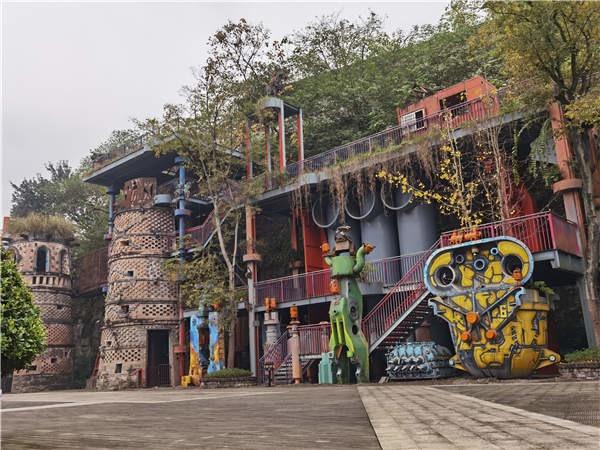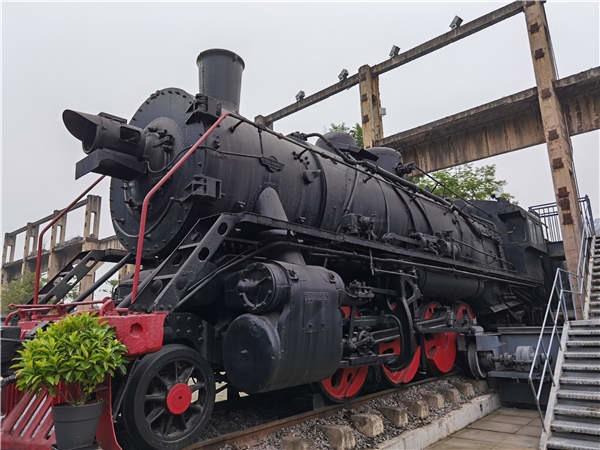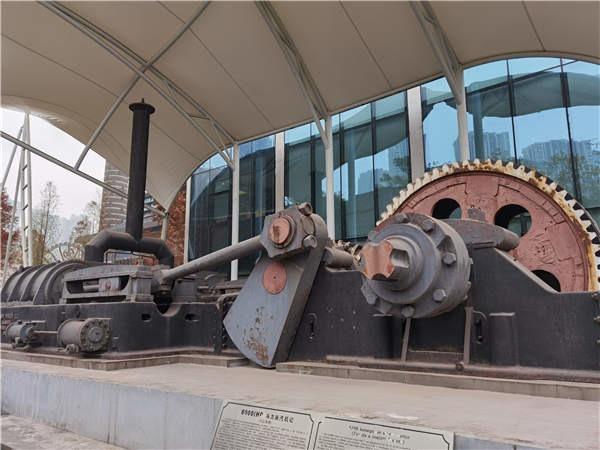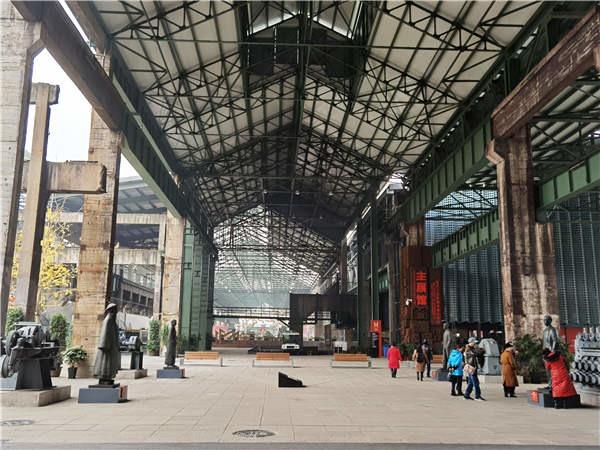 Artists turn some former facilities of the steel plant into contemporary art pieces. (WANG KAIHAO / CHINA DAILY)
Artists turn some former facilities of the steel plant into contemporary art pieces. (WANG KAIHAO / CHINA DAILY)
Steel can represent more than a nation's industry. It can also symbolize and even embody its unswerving spirit and shared determination.
Chimneys, iron frames, tramcars and steel ladles are still there, seemingly ready to usher people back to an old story about a cradle of China's modern industry
A visit to the former steel plant by the Yangtze River in Chongqing municipality offers more than viewings of old steampunk elements.
For many Chinese, it's like a pilgrimage to pay homage to their predecessors' endeavors and toughness during trying times.
The plant has been converted into the Chongqing Industrial Museum. The venue in Dadukou district opened to the public in September 2019, on the eve of the 70th anniversary of New China's founding.
Chimneys, iron frames, tramcars and steel ladles are still there, seemingly ready to usher people back to an old story about a cradle of China's modern industry.
In 1890, Zhang Zhidong, the viceroy of Huguang, the chief official of today's Hubei and Hunan provinces, undertook an ambitious initiative to construct Hanyang Iron Works in Hubei's provincial capital, Wuhan. China's first modern steel producer became the foundation for the country's industry.
ALSO READ: Restorers piece together terracotta warriors
 A locomotive inside the museum is a popular subject for social media posts for nostalgic visitors. (WANG KAIHAO / CHINA DAILY)
A locomotive inside the museum is a popular subject for social media posts for nostalgic visitors. (WANG KAIHAO / CHINA DAILY)
Between its founding and the Qing Dynasty's (1644-1911) fall, it produced almost all of China's steel, until more plants appeared in the following years. Yet it remained a pillar of Chinese industry.
In March 1938, the frontline of the War of Resistance Against Japanese Aggression (1931-45) was approaching Wuhan.
To prevent this key facility from falling into the enemy's hands, a Steel Plant Relocation Committee, or SPRC, was established to move the dismantled machinery and equipment in Wuhan west to Chongqing, which later became China's provisional capital during the war.
With great pain, China deliberately destroyed the remaining constructions in the Wuhan plant before the city fell.
The 1,200-kilometer journey along the Yangtze River was an adventure in the face of continuous Japanese bombings and the shoals of the Three Gorges.
Nevertheless, over 323,000 tons of equipment arrived in Chongqing. The SPRC plant resumed operating in Dadukou district in 1939.
According to historical files collected by the museum, the SPRC plant in Chongqing provided over 90 percent of the steel consumed by Chinese arsenals during the war. A cluster of wartime-arsenal sites in Chongqing, including the plant, were inscribed on a list of national-level key heritage sites by the State Council in 2013.
 A steam engine bought from the United Kingdom in 1906 was a crucial witness of the glorious history of the steel plant. (WANG KAIHAO / CHINA DAILY)
A steam engine bought from the United Kingdom in 1906 was a crucial witness of the glorious history of the steel plant. (WANG KAIHAO / CHINA DAILY)
Yan Yangchu, a famous educator then, hailed the painstaking relocation of industrial equipment during the war as "the Dunkirk moment of Chinese industry".
"This steel plant's contributions to China's victory in the War of Resistance Against Japanese Aggression is ineffaceable," the museum's deputy director Guan Yongqin says.
Guan proudly introduces a steam engine Zhang Zhidong bought from the United Kingdom in 1906 as the most important exhibit.
From its early days in Wuhan and through the wartime years-some of its components were even sunk into the Yangtze by Japanese bombs and salvaged after the war-it continued working until 1985, when new machines replaced it.
It can still function today, Guan says.
After New China's 1949 founding, the Chongqing Iron and Steel Company continued to witness many milestones in China's industrial development. For example, the first Chinese rail was made there in 1950.
On May 18, International Museum Day, a Chongqing Industrial Museum exhibition was listed among the country's top 10 exhibitions of 2020 by the National Cultural Heritage Administration.
The large-scale steel-manufacturing machines may offer subject matter for social media posts. But it's a nostalgic place for Chongqing residents, especially the elderly.
In addition to wartime photos and relics, an exhibition hall that's also a former steel plant ushers visitors across a century through displays of various old items. It shows how Chongqing's modern industry started from nothing and gradually transformed the city into an economic hub in western China.
Modern industries mushroomed in the city after the opening-up of the 1890s, starting with a match factory. Such sectors as automobile and textile manufacturing boomed, as have high-tech industries in recent years.
An old TV set with only eight buttons reminds us that everything familiar in our everyday lives may end up in museums much sooner than we expect.
 The Chongqing Industrial Museum was converted from the former site of an iconic steel plant as a symbol of a country's strong spirit. (WANG KAIHAO / CHINA DAILY)
The Chongqing Industrial Museum was converted from the former site of an iconic steel plant as a symbol of a country's strong spirit. (WANG KAIHAO / CHINA DAILY)
But a juxtaposition of "Chongqing products" hung from the exhibition hall's ceiling-mechanical clocks, cameras and ancient handicrafts like pottery-points to another thought: No matter how time changes, such items' legacies last and encourage people to continuously create new things.
Another relocation came in 2011, when Chongqing Iron and Steel was moved out of downtown to better protect the environment.
"It's even more costly to refurnish the old factory to match the criteria of the exhibitions than building a new museum," Guan says.
"But it's worth it. The neighboring communities won't thrive if we don't revive this site."
It took eight years to finish the project. A principle of "minimum intervention" was adopted to retain historical information, and all marks of renovation are recognizable and reversible, if needed in the future.
Dadukou's economy previously relied on Chongqing Iron and Steel, so it needed to find new ways to cultivate prosperity.
"The museum is like a window into our district," deputy director of Dadukou's culture and tourism committee Fan Yongli says.
READ MORE: Sculpture exhibition stages sixth edition
"Since the old industry is gone, we need to make local communities dynamic again through tourism."
She says a cultural park centered on the industrial museum is being planned.
"The museum can also be a hub for cultural creativity," she says.
For example, its industrial elements have inspired designers to create popular souvenirs.
And artists have given the rusted iron frames new life. The colorful outdoor art pieces seem reminiscent of the Transformers.
Indeed, the site is a reminder of how steel has, itself, always been a remarkable transformer.


